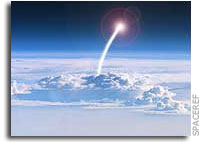NRC Report: Revitalizing NASA’s Suborbital Program: Advancing Science, Driving Innovation, and Developing Workforce

The Space Studies Board (SSB) was requested by NASA to conduct a review of the suborbital mission capabilities of NASA in the NASA Authorization Act of 2008 (Section 505). The act expresses the sense of Congress that suborbital flight activities, including the use of sounding rockets, aircraft, and high-altitude balloons, and suborbital reusable launch vehicles, offer valuable opportunities to advance science, train the next generation of scientists and engineers, and provide opportunities for participants in the programs to acquire skills in systems engineering and systems integration that are critical to maintaining the nation’s leadership in space programs. Further, the act finds it in the national interest to expand the size of NASA’s suborbital research program and to consider it for increased funding.
STATEMENT OF TASK
The Space Studies Board established the ad hoc Committee on NASA’s Suborbital Research Capabilities to assess the current state and potential of NASA’s suborbital research programs and conduct a review of NASA’s capabilities in this area. The scope of this review included:
- Existing programs that make use of suborbital flights;
- The status, capability, and availability of suborbital platforms and the infrastructure and workforce necessary to support them;
- Existing or planned launch facilities for suborbital missions; and
- Opportunities for scientific research, training, and educational collaboration in the conduct of suborbital missions by NASA, especially as they relate to the findings and recommendations of the National Research Council’s decadal surveys and recent report Building a Better NASA Workforce: Meeting the Workforce Needs for the National Vision for Space Exploration.
The committee was asked to consider airborne platforms broadly and to include the Stratospheric Observatory for Infrared Astronomy, although it is not part of the suborbital program per se.
The NASA Authorization Act of 2008 (Section 505) (see Appendix A) expressed the sense of Congress that suborbital flight activities, including the use of sounding rockets, aircraft, high-altitude balloons, and suborbital reusable launch vehicles, offer valuable opportunities to advance science, train the next generation of scientists and engineers, and provide opportunities for participants in the programs to acquire skills in systems engineering and systems integration that are critical to maintaining the nation’s leadership in space programs. The authorizing legislation from Congress stated that Congress believes that it is in the national interest to expand the size of NASA’s suborbital research program. It was further stated that funding for suborbital research activities should be considered part of the contribution of NASA to United States’ competitive and educational enhancement and should represent increased funding as contemplated in section 2001 of the America COMPETES Act (42 U.S.C. 16611(a)).
To assess the current state and potential of NASA’s suborbital research programs, the act directed NASA to enter into an arrangement with the National Academies to conduct a review of NASA’s capabilities in this area. At the request of NASA, the National Research Council (NRC) established the ad hoc Committee on NASA’s Suborbital Research Capabilities (biographies of the committee members appear in Appendix F) in January 2009. The committee was tasked with addressing the following topics: the existing programs that make use of suborbital flights; the status, capability, and availability of suborbital platforms and the infrastructure and workforce necessary to support them; existing or planned launch facilities for suborbital missions; and opportunities for scientific research, training, and educational collaboration in the conduct of suborbital missions by NASA (the statement of task is given in Appendix B).








